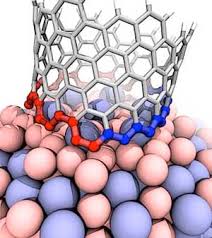Tribal Behavior Enhanced Coating of CNT Carbon Nanotubes (Based on Nano-Micro-Electronic PHD) Educational-Research PhD
Researcher and author PhD student : Afshin Rashid
Note: A CNT nanotube is a member of the fluorine family, which also includes bucky wings. Fluorine is a large cluster of carbon atoms in the form of a closed cage and has certain properties that were not found before in any other compound. Therefore, fluorides generally form an interesting family of compounds that will definitely be widely used in future applications and technologies.
Carbon nanotubes (CNTs) are a type of carbon allotropic. They are cylindrical in shape and have amazing properties that make them suitable for use in many applications of nano-microelectronics, optics and other fields of science. They have extraordinary strength, unique electrical properties, and are efficient conductors for heat. There are many strange structures of fluorine, including regular spherical, conical, tubular, as well as other complex and strange shapes . The wing ball structure is in the shape of a sphere and the nanotube is cylindrical in shape, usually at least one side of it is covered with a semi-spherical cover of the wing wing structure.
In nanotechnology, liquid nitrogen medium was used to produce carbon nanotubes by the arc method. The liquid medium creates an oxygen-free environment for the reaction and cooling of the products. Therefore, using a liquid environment, this method becomes cheaper and more cost- effective. Nanotubes, like graphite, are completely formed and give these molecules their unique strength . Nanotubes are typically powered by van der Waals .
The strings stick together. Under high pressure, the nanotubes can be mixed together and it is possible to produce unlimited and very strong wires.
Conclusion:
A CNT nanotube is a member of the fluorine family, which also includes bucky wings. Fluorine is a large cluster of carbon atoms in the form of a closed cage and has certain properties that were not found before in any other compound. Therefore, fluorides generally form an interesting family of compounds that will definitely be widely used in future applications and technologies.
Author: PhD Student ( Afshin Rashid)
PhD student in Nano-Microelectronics at Islamic Azad University, Science and Research Branch, Tehran




